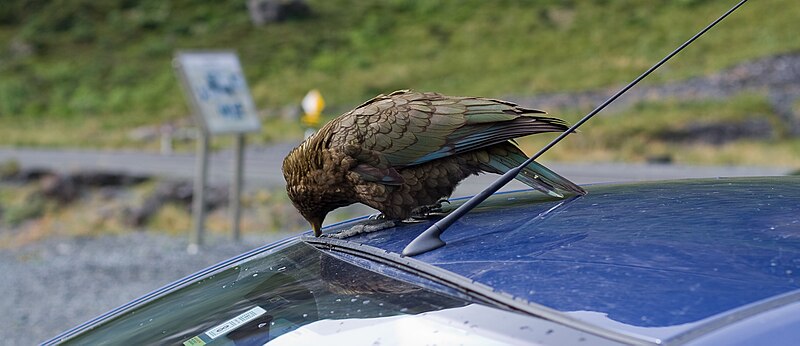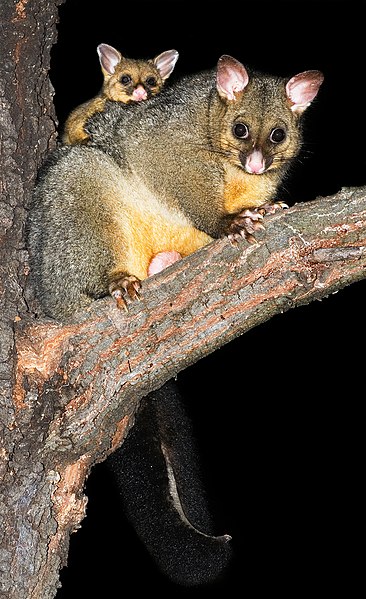 New Zealand’s endemic parrot, the Kea (Nestor notabilis), was nearly driven to extinction by ranchers who believed the bird was a threat to their sheep (please see below). Hunting is now outlawed, but the Kea’s troubles are not over – a recent study has documented that stoats, possums and rats, all introduced from elsewhere, are eating chicks and attacking adults.
New Zealand’s endemic parrot, the Kea (Nestor notabilis), was nearly driven to extinction by ranchers who believed the bird was a threat to their sheep (please see below). Hunting is now outlawed, but the Kea’s troubles are not over – a recent study has documented that stoats, possums and rats, all introduced from elsewhere, are eating chicks and attacking adults.
A Most Unusual Parrot
The Kea’s Latin species name, “notabilis”, could not be more fitting, for surely it is a most “notable” bird. What other parrot causes trouble by attacking parked cars – stripping rubber from around windows – on a regular basis (please see photo)? Consider its other unique characteristics, most of which are completely unknown among “normal” parrots:
Keas dwell in alpine regions and often walk about in the snow
They are largely nocturnal, but also forage by day
Ground nesting, below rocks or in hollow logs, is typical
Keas have attacked sheep and consume carrion
They forage in the fur of living sheep for fly larvae
Keas soar, hawk-like, on mountain air currents
Males may mate with up to 4 females each season
A Plague of Introduced Predators
 Yet despite highly-developed intelligence and an aggressive streak, Keas are, like many other birds that evolved on mammal-free islands, largely at the mercy of non-native predators. Brush-tailed possums (please see photo), introduced to New Zealand to stimulate the fur trade, and stoats (ferret relatives), which were brought to the island to help control introduced rabbits, are especially troublesome.
Yet despite highly-developed intelligence and an aggressive streak, Keas are, like many other birds that evolved on mammal-free islands, largely at the mercy of non-native predators. Brush-tailed possums (please see photo), introduced to New Zealand to stimulate the fur trade, and stoats (ferret relatives), which were brought to the island to help control introduced rabbits, are especially troublesome.
Rats, also non-native, present another problem – in addition to eating eggs and chicks, rats soar in numbers when certain trees bear fruit. Stoats are then attracted to such areas, where they consume Kea chicks along with rats.
Videos Document Attacks on Nests
 While non-native mammals were assumed to be a problem for Keas, it was not until the New Zealand Department of Conservation installed cameras near Kea nests that the scope of the danger was documented. Although the 2010 breeding season has months to go, 3 of 11 nests monitored have been attacked.
While non-native mammals were assumed to be a problem for Keas, it was not until the New Zealand Department of Conservation installed cameras near Kea nests that the scope of the danger was documented. Although the 2010 breeding season has months to go, 3 of 11 nests monitored have been attacked.
The video linked below shows possums and stoats preying upon Kea chicks (Please note: the images may be disturbing to some folks). The possum attack was particularly surprising, as they were believed to take only eggs or dead chicks, and not to be aggressive predators (I’ve cared for Brush-tailed Possums in zoos, and can attest that their teeth can make short work of most any bird!).
Based on the videos and other research, conservation officials are revising their predator control plans and monitoring fruit tree production so as to be able to predict spikes in the rat population.
Further Reading
Video of possums and stoats attacking Keas.
Kea image referenced from wikipedia and originally posted by Markus Koljonen
Kea on car referenced from wikipedia and originally posted by Joshin Yamada
Brushtail Possum image referenced from wikipedia and originally posted by Noodle Snacks
 That Bird Blog – Bird Care and History for Pet Birds
That Bird Blog – Bird Care and History for Pet Birds



